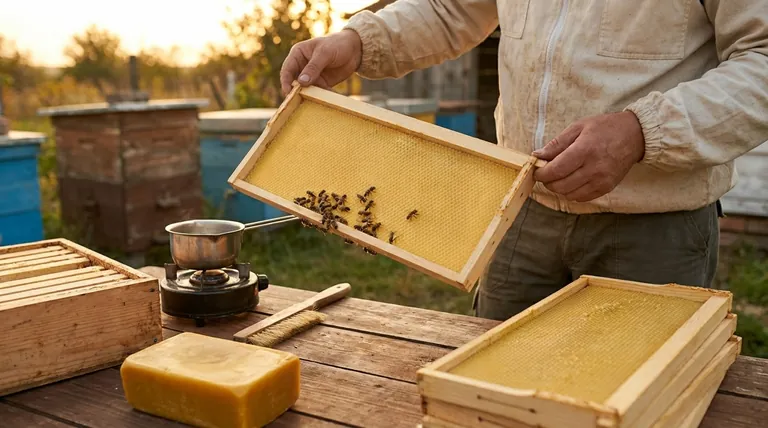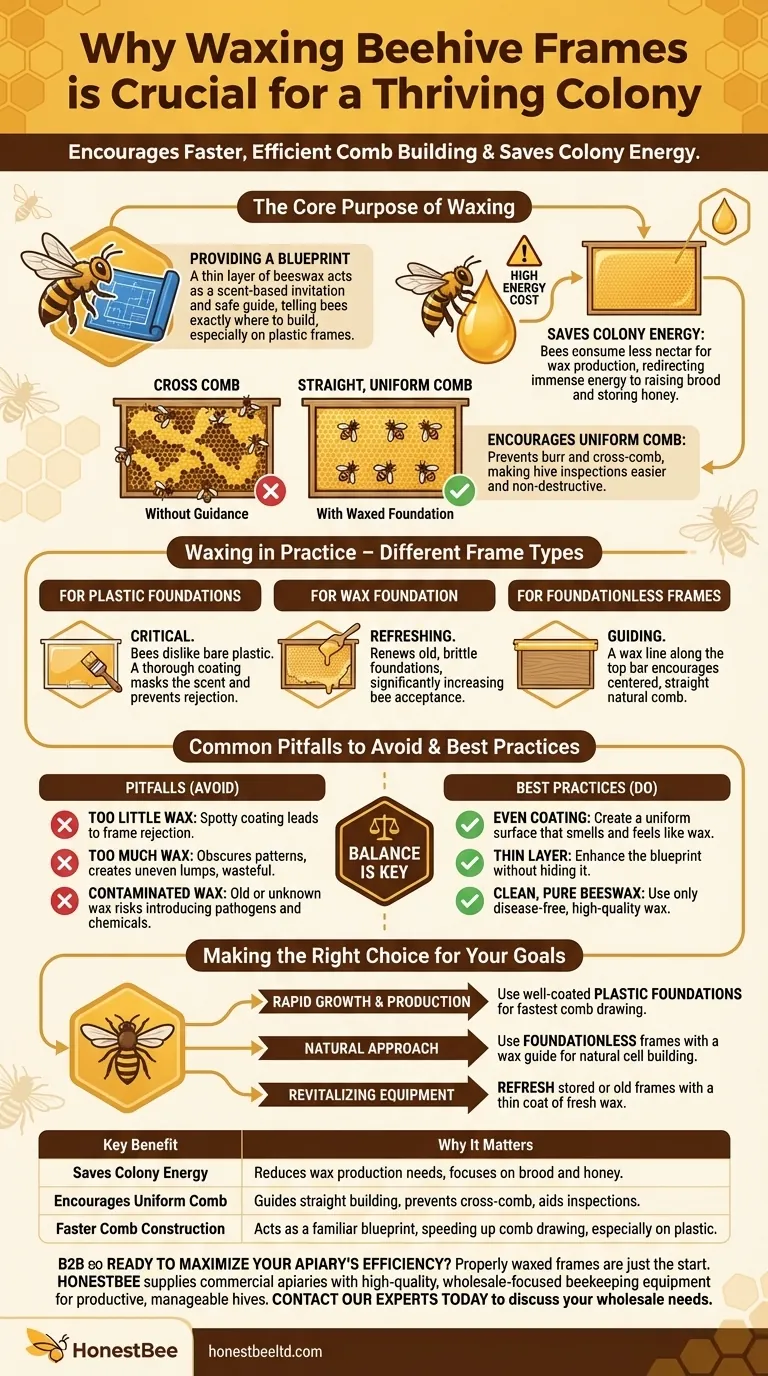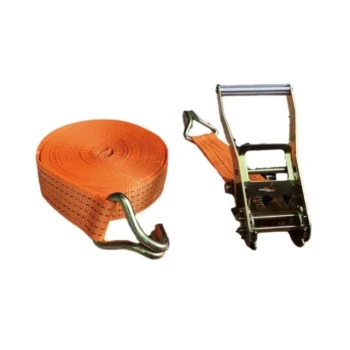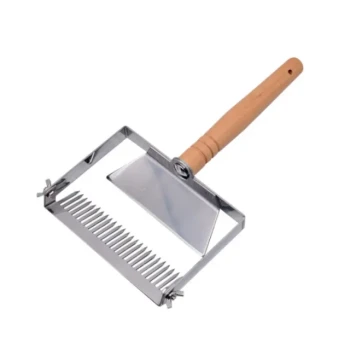The primary reason for waxing beehive frames is to encourage bees to build their comb faster and more efficiently. Applying a thin layer of beeswax acts as a blueprint and a "scent-based" invitation, saving the colony significant time and energy that would otherwise be spent producing all the wax from scratch.
The core purpose of waxing is to bridge the gap between a man-made hive component and the bees' natural instincts. It communicates to the colony exactly where you want them to build, leading to a more productive and manageable hive.

The Core Purpose of Waxing a Beehive Frame
Bees are master architects, but their work requires immense resources. Waxing a frame gives them a critical head start, aligning their natural behavior with the beekeeper's goals for a strong, organized colony.
Providing a "Blueprint" for Construction
A fresh frame, especially a plastic one, is a foreign object to bees. A coating of pure beeswax provides a familiar scent and texture.
This wax layer essentially tells the bees, "This is a safe and correct place to build." It gives them a clear starting point and guide for drawing out the cells of the comb.
Saving the Colony's Energy
Bees must consume large quantities of nectar or honey to power the glands that produce wax. This is an enormous biological expense for the colony.
By providing a waxed foundation, you give them the basic structure they need. This allows the colony to redirect its energy from wax production toward other vital tasks like raising brood, foraging for nectar, and storing honey.
Encouraging Uniform Comb
Without guidance, bees may build "cross comb" or "burr comb" that connects multiple frames together. This makes hive inspections incredibly difficult, disruptive, and can result in destroying brood or honey-filled cells.
A properly waxed frame or foundation encourages bees to build straight, even combs that remain within the confines of a single frame. This is essential for modern, non-destructive beekeeping.
Waxing in Practice: Different Frame Types
The need and method for waxing depend on the type of frame and foundation you are using.
For Plastic Foundations
This is the most common and critical use case for applying wax. Bees are often highly reluctant to work on bare plastic.
A thorough coating of beeswax is necessary to mask the plastic scent and provide a workable surface. Without it, bees will often ignore the frame completely, leading to a "chimney" effect where they only build comb in the center of the hive.
For Wooden Frames with Wax Foundation
Most commercial wax foundations come with a light coating of beeswax. However, if this foundation has been in storage for a long time, it can lose its scent and become brittle.
Applying a very thin, fresh coat of melted beeswax can refresh the scent and make an old foundation much more attractive to the bees, significantly increasing its acceptance rate.
For Foundationless Frames
Even when allowing bees to build their own comb without a foundation, waxing plays a role. Beekeepers often run a line of melted wax along the top bar's guide or in the frame's groove.
This small wax guide encourages the bees to start their comb in the center and build it straight down, reducing the likelihood of cross comb.
Common Pitfalls to Avoid
While waxing is beneficial, improper application can cause problems. Understanding the balance is key to success.
Applying Too Little Wax
This is the most frequent mistake, especially with plastic foundations. If the coating is too thin or spotty, the bees may still reject the frame. The goal is to create a surface that smells and feels like wax, not plastic.
Applying Too Much Wax
A thick, heavy coat of wax is wasteful and can be counterproductive. It can obscure the embossed cell pattern on a foundation, making the guide less effective. Excessive wax can also create uneven drips and lumps that bees have to work around.
Using Old or Contaminated Wax
Only use clean, pure beeswax. Old wax from diseased hives or dirty burr comb can potentially harbor pathogens. Furthermore, wax readily absorbs chemicals, so using wax from an unknown source risks introducing contaminants into your hive.
Making the Right Choice for Your Colony
Applying wax is a simple step that pays significant dividends in hive productivity and manageability. Your approach will depend on your specific beekeeping goals.
- If your primary focus is rapid growth and honey production: Use high-quality, evenly coated plastic foundations to get bees drawing comb as quickly as possible.
- If your primary focus is a more natural approach: Use foundationless frames with a simple wax guide along the top bar to let bees build their own natural-sized cells.
- If your primary focus is using existing or old equipment: Revitalize stored wax or plastic foundations with a fresh, thin coat of clean beeswax to ensure the bees will accept and use them.
Ultimately, waxing frames is a fundamental technique that aligns your goals with the bees' natural instincts, fostering a healthier, more organized, and productive colony.
Summary Table:
| Key Benefit | Why It Matters |
|---|---|
| Saves Colony Energy | Reduces the bees' need to produce wax from scratch, allowing them to focus on brood rearing and honey production. |
| Encourages Uniform Comb | Guides bees to build straight combs, preventing problematic cross-comb and making hive inspections easier. |
| Faster Comb Construction | Acts as a familiar blueprint, especially on plastic foundations, significantly speeding up the drawing of new comb. |
Ready to maximize your apiary's efficiency? Properly waxed frames are just the start. HONESTBEE supplies commercial apiaries and beekeeping equipment distributors with the high-quality, wholesale-focused supplies needed for productive, manageable hives. From durable frames to pure beeswax, we provide the reliable equipment that supports strong colonies. Contact our experts today to discuss your wholesale needs and see how we can help your operation thrive.
Visual Guide

Related Products
- Wooden Bee Hive Frames for Beekeeping and Wholesale
- Copper Bee Frame Eyelets for Beekeeping
- 3D Beehive Silicone Skep Wax Candle Molds for Candles
- HONESTBEE Professional Long Handled Hive Tool with Precision Cutting Blade
- Professional Galvanized Hive Strap with Secure Locking Buckle for Beekeeping
People Also Ask
- When should bee frames be thrown away? A Beekeeper's Guide to Hive Health & Biosecurity
- What color options are available for plastic frames, and what is the benefit of black frames? Boost Your Hive Inspection Efficiency
- What is the role of oxalic acid in plants? A Key to Plant Defense and Internal Regulation
- Will honey bees clean up old frames? A Guide to Safe and Efficient Frame Reuse
- What are the primary uses of different Langstroth frame sizes? Optimize Your Hive for Health & Honey



















